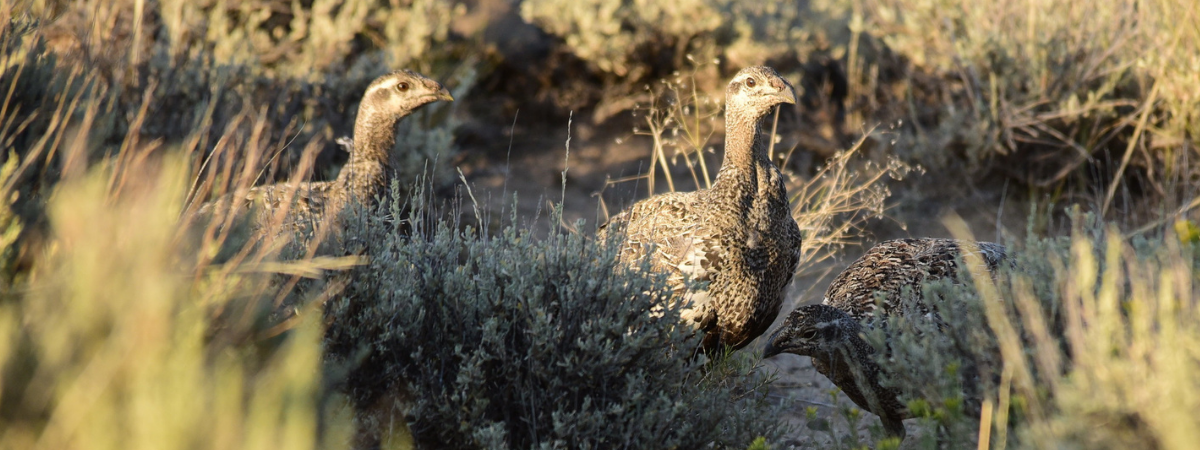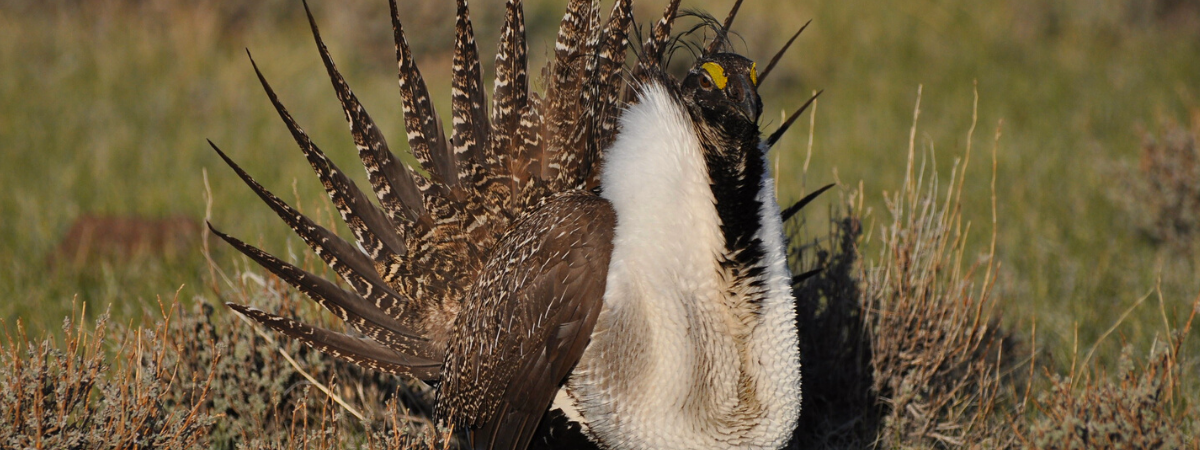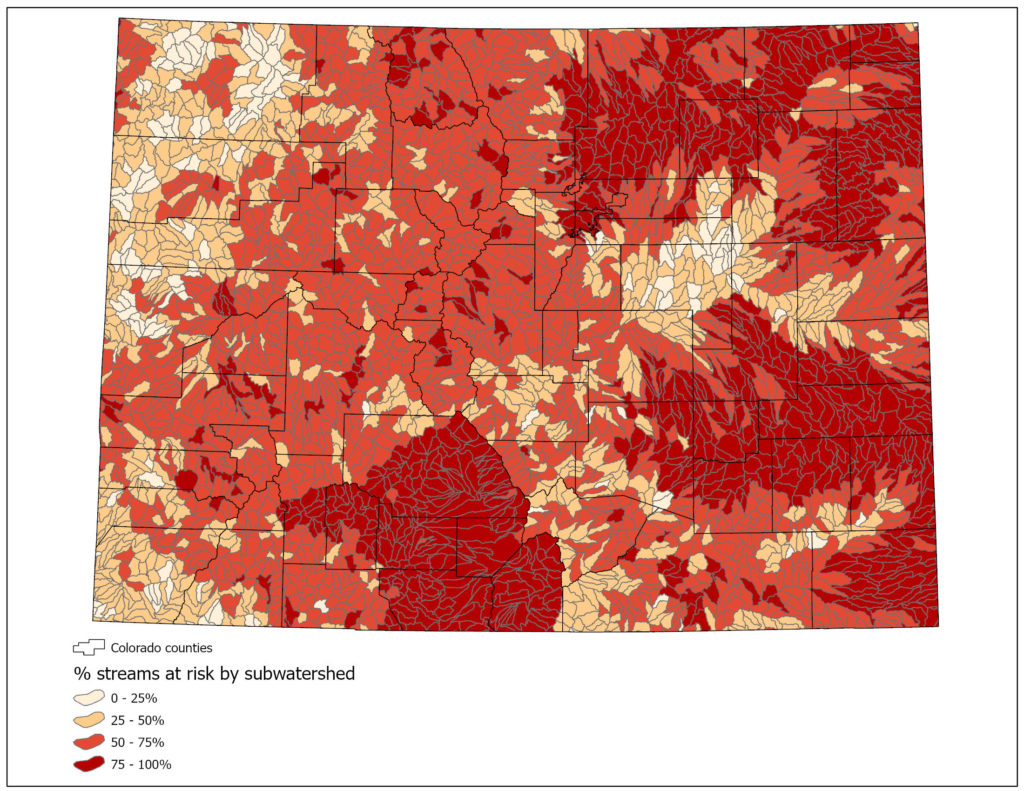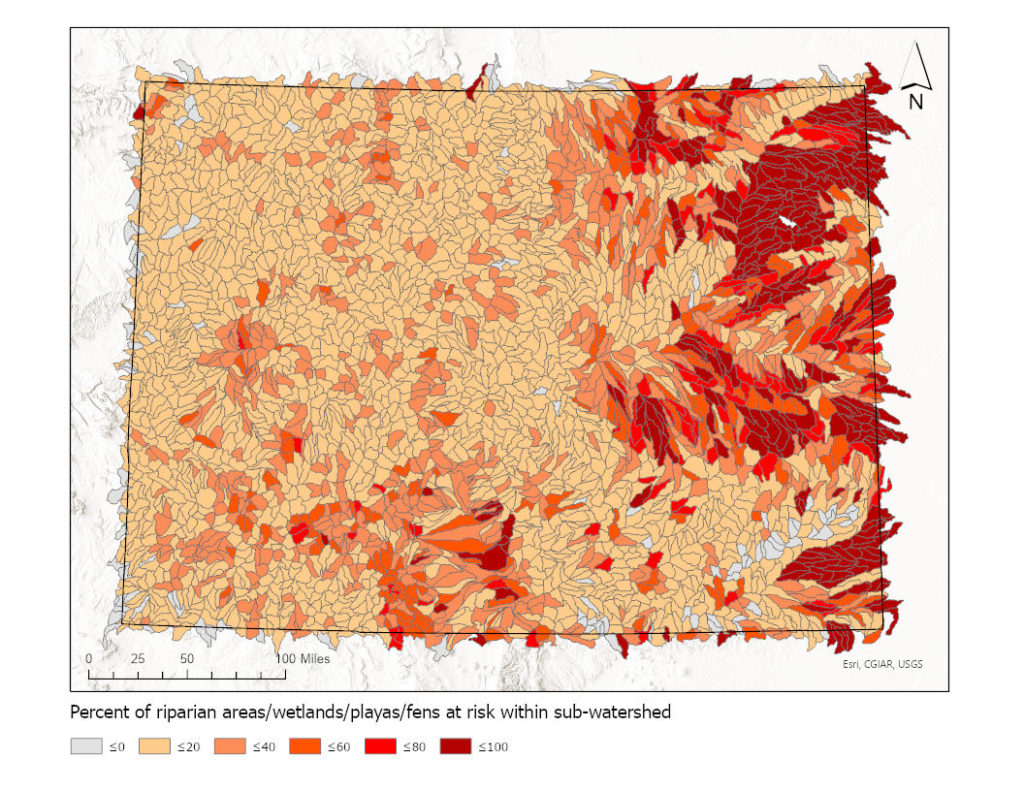Here’s why these once abundant game birds are in even worse shape than we thought and what must come next in the effort to restore sagebrush habitat
Springtime in the West brings many familiar sounds to those spending time in the outdoors, and few can rival the peculiarity and excitement of hearing male sage grouse calling to potential mates as they dance on their breeding grounds. Known as leks, these literal stomping grounds are where biologists can reliably count birds with some degree of consistency to gauge the health of the species.
But fewer and fewer male sage grouse are showing up to leks, and that has scientists, managers, and sportsmen and women deeply concerned.
In fact, the U.S. Geological Survey recently released a grim report on sage grouse populations. Their analysis showed that there are 80 percent fewer males dancing on their leks across the Western landscape than in 1965, and half of that loss has occurred in just the last 17 years. The long-term trend averages out to be about 3 percent fewer birds at leks each year.
While some areas are showing recent increases in bird abundance, about 45 percent of remaining leks are predicted to disappear in the next 20 years and 78 percent could be gone in 56 years—unless conditions change.
I’ve explained in previous blogs that short-term and long-term factors can affect lek counts, which is why year-over-year gains shouldn’t necessarily be celebrated. (Read more about that here.) Strong precipitation for a single season or two may boost sage grouse numbers in a state or region, but the overall downward trend has actually continued and deepened for this iconic game bird.

In a separate announcement in early March, the USGS reported that only 55 percent of the historical extent of sagebrush habitat now remains. Here are five key reasons why:
Ten percent of sagebrush has been converted to cropland.
Studies demonstrate that tillage rates of only about a quarter of a given landscape around leks can cause male grouse to abandon them. Cropland conversion also fragments the landscape more broadly and reduces the suitability of the remaining smaller patches of sagebrush. Cultivated lands no longer in production can take decades to recover and may even be permanently degraded from prior use of herbicides.
Energy development and mining have affected millions of acres of sagebrush.
This includes activities related to oil and gas and renewables, such as wind and solar. Impacts from development are well documented and remove habitat outright or render some of the remaining habitat nearby unusable to sage grouse due to disturbance around the infrastructure.
More than 20 percent of sagebrush habitat in the Rocky Mountain region has been affected by oil and gas development and mining. We also know that millions of acres of priority sage grouse habitat were leased for oil and gas development during the last administration, and many impacts from existing development were never fully mitigated in recent years.
Conifers are creating imbalance on the landscape.
Across the West, juniper and pinyon pine trees—native species to these landscapes—have expanded dramatically since European settlement and this has consequences for sagebrush and wildlife. Conifer expansion changes the vegetation and can negatively alter wildlife use, water and nutrient cycles, carbon storage, and resistance to invasion from invasive plant species. Removing conifer trees in sagebrush stimulates the growth of forbs and bunchgrasses up to 20 times over. Unfortunately, while conifer removal has occurred across wide swaths of land in the West, the expansion continues to outpace removal, and we continue losing ground to this threat.
Climate change is accelerating threats to habitat.
Parts of the West are experiencing a 20-year megadrought, a clear sign that our changing climate is altering landscapes and making it more difficult to repair them once they are damaged. Warmer spring temperatures mean drier soil earlier in the season, and that leads to longer periods of hot and dry conditions during summer. In turn, these hotter and drier conditions leave plants with less resistance to wildfire.
These altered fire cycles have had enormous impacts on sage country, where fire season is now 134 percent longer. The enormity of these fires has also increased substantially over the past two decades, according to the USGS report. Since 2000, more that 20 percent of priority habitat management areas for sage grouse within the Great Basin alone have burned, in part due to climate conditions. And the next few decades are predicted to be even worse, further threatening the sagebrush ecosystem without serious investment and intervention.
Invasive cheatgrass is fueling more (and hotter) fires.
And then there’s cheatgrass—an insidious non-native annual grass that has expanded across the West and particularly in the arid Great Basin region. This invasive species contributed to altering the normal fire cycle, producing much larger and more intense and frequent wildfires that consume huge expanses of sagebrush. Left unchecked, invasive plants degrade plant communities, wildlife habitat, and migratory corridors and threaten wildlife survival. They also can cause significant negative economic impacts.
Worse yet, like expanding conifers and wildfires, current management programs are addressing less than 10 percent of cheatgrass infestations—far more acres are becoming infected than are being treated, and agencies will continue to struggle to keep pace without robust funding.
The truth is that no one factor is affecting the entire range of the greater sage grouse, but this holistic and long-term picture of loss in sage grouse country points to one sure thing: an immediate need to conserve remaining habitat AND provide greater investments in sagebrush restoration.

What Comes Next for Sage Grouse Conservation
There was some good news in the USGS reports: Scientists have developed some amazing new tools to help wildlife managers better detect when sage grouse populations may be in trouble. These “early warning systems” will hopefully improve the ability to address problems faster as conservation plans are being implemented.
The Western Association of Fish and Wildlife Agencies has also been developing a broader sagebrush conservation strategy to help guide the collective efforts of local, state, tribal, and federal government agencies and nongovernmental stakeholders across all scales to conserve the sagebrush ecosystem.
Still, just implementing the current conservation plans and mitigating all future impacts may not be enough. With so many millions of acres of sagebrush in degraded conditions, we need massive investments in habitat restoration on top of implementing the conservation plans already in place.
Combating cheatgrass will take years and likely billions of dollars of investment. Removing invading conifers that can overtake sagebrush habitats already has been conducted across the West, but not nearly fast enough or across enough acres.
However, with challenges like these also come opportunities. The Biden Administration has put forth an aggressive climate change agenda and could be sold on restoration efforts in the sagebrush ecosystem that can put people to work while improving carbon storage and the resilience of these habitats to climate change.
This is an opportunity, if we view it as such. We need Congress, federal and state agencies, and the private sector to make the necessary investments in conservation and restoration that will reap many rewards for all stakeholders in the future.
Sportsmen and women have, of course, been on the frontlines of sage grouse conservation for decades, and our dollars—through licenses, habitat stamps, and Pittman-Robertson funds—have and will continue to support sage grouse conservation.
We’ve also sacrificed along the way. Over the past several years, most Western state wildlife agencies have made major adjustments to the harvest of sage grouse. Season closures have been carried out the right way where it has mattered most.
It has been demonstrated time and time again that regulated hunting of sage grouse is not a major threat to overall population status, but these continued downward trends cannot be ignored by state wildlife agencies. Hunters may yet again see more changes to hunting seasons and bag limits, and perhaps closures, in the coming years because of habitat losses.
Our state wildlife agencies must do their jobs and will continually adjust the harvest to ensure that less than 10 percent of the estimated total population of sage grouse are taken each fall. But sportsmen and women must do theirs too.
One fear is that with more hunting restrictions and closures hunters will lose interest in sage grouse and conservation of its ecosystem. However, this is not the time to relax on advocating for strengthening conservation efforts.
Reversing these population and habitat trends was never going to be an easy task – even back when the bird was first proposed for listing as threatened or endangered. Now, the hole to dig out of is even deeper. We still need all hands on deck in sage grouse country, and that includes sportsmen and sportswomen advocating for decisive steps to conserve the sagebrush ecosystem.
Images courtesy of USFWS, Tom Koerner







It’s a shame that the bipartisan plan to safeguard Sage grouse habitat was abandoned by the previous administration after years of compromise to assure sustainable populations. I had the fortunate opportunity to combine hunting Sage Grouse in Wyoming while on an Antelope hunting trip. It turned out to be a special upland hunt my son and I will always remember harvesting this iconic species. Sportsmen need to come together with other economic drivers to put a real sustainable plan in place for habitat protection before the population becomes to fragmented.
Well stated, Ed. You condensed lengthy and complex documents into a digestible and comprehensible piece.
Besides the change in the fire regime throughout the west brought on by invasive species, what I don’t see in this article the damages done to Sage Grouse by the possible affects of the West Nile Virus. It came to us in the early 2000’s and the biggest declines in their population seem to have occurred in the same time frame.
I agree with West Nile virus affecting them a lot cause in my area things were stable until this hit. Now everything all over is in trouble seems like.
I have a hard time believing that 55% of sage habitat remains. I would have bet less than 25%.
…and then, there are the sacred cows (and horses). How many acres of sagebrush have been converted to grass for cows by chaining, and herbicides, and targeted burning? Maybe most before 1965? Certainly these days there are bright spots of enlightened ranchers and grazing systems, yet there still seem to be too many examples of overgrazing in many places. Sometimes this results in too dense sagebrush stands and/or fewer forbs than optimum habitat would dictate. How has grazing fostered cheat? The science of cumulative effects and multivariate models is hardly straightforward, and I agree that we need not to look for a univariate answer to a multivariate problem. Grazing problems are certainly not the magic factor, and “green side up” is always better than “roots up”. Thanks for fine insights, Ed. “Nothing simple is ever easy” –as a former colleague used to say.
…What can I do as a sportsman to help? Thank you…
I love my TRCP, but we have to start moving domestic cattle off public lands…that is a first!